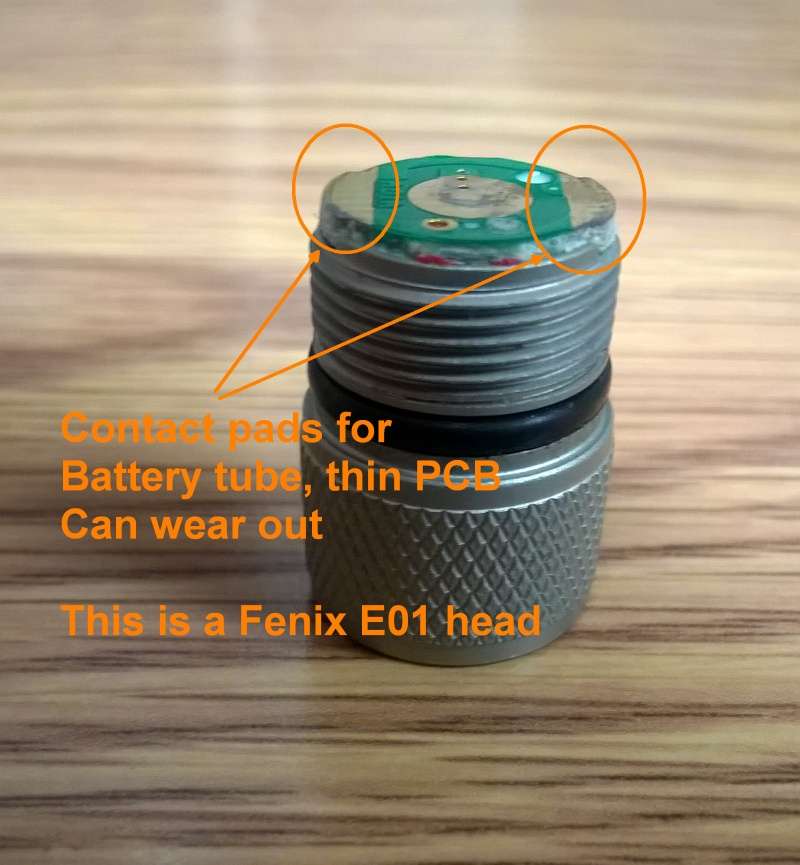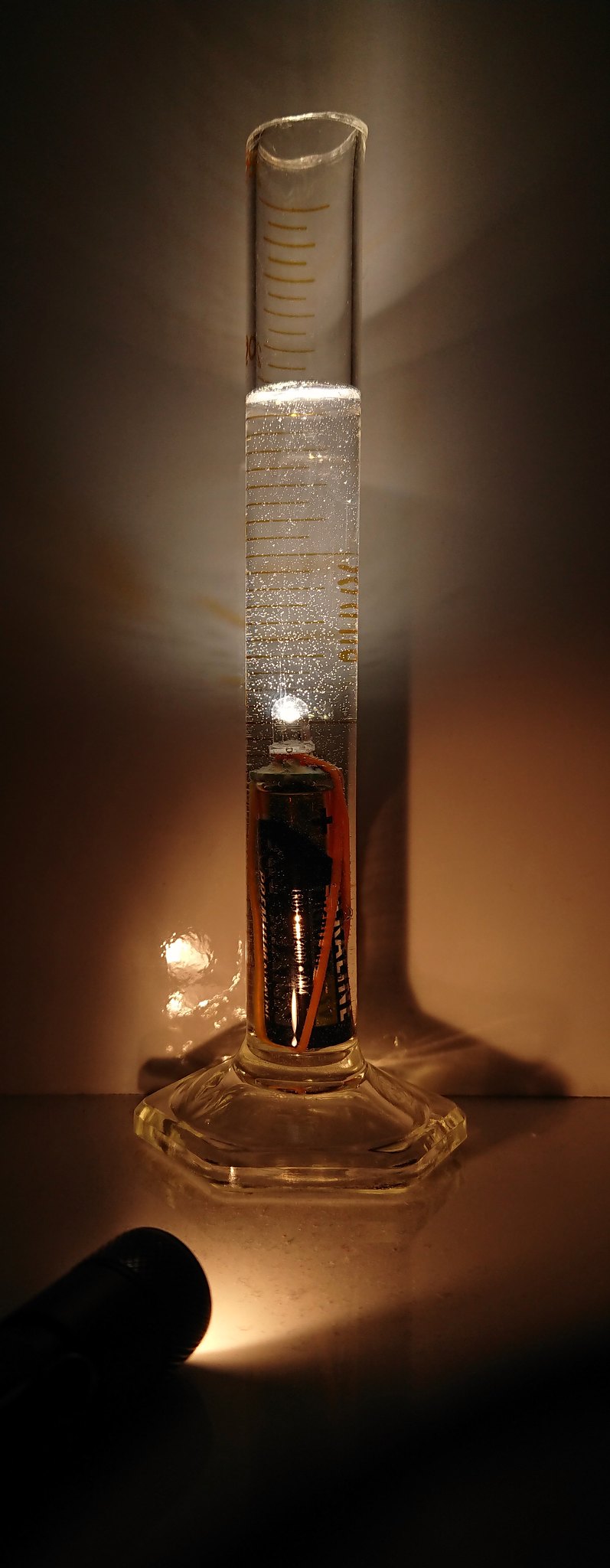Here’s a comparison image of the Fenix E01 I dug up (source). Although it looks like it covers a larger area, I don’t think the actual contact area with the body is larger. It looks quite thin, but seems to hold up ok:

Here’s a comparison image of the Fenix E01 I dug up (source). Although it looks like it covers a larger area, I don’t think the actual contact area with the body is larger. It looks quite thin, but seems to hold up ok:

“contact pads can wear out”
This is what everyone says and it looks to me a fragile point in the design too, but does it indeed wear out in practice is the question, is that tested? Not in 800 or so twist cycles at least so I just found.
Yeah, from your pic, it looks like the actual trace is fine, just the solder coating is rubbed away.
To be clear, I’m really not worried about these pads. If a very similar design works for Fenix on a $12 (US) light, I’m not going to worry about it on a $6.50 light, especially not after you went the extra mile (and thanks for doing so!) to manually test the copy you have been carrying.
If I’m unreasonably extrapolating the experience with a similar light, I will just have to accept my mistake years from now when the hypothesized issue manifests itself.
I’ve had my E01 since they were first released and it’s been very heavily used, it’s contacts look nowhere near as worn down as djozz’s light. Perhaps I don’t twist as aggresively? I don’t know.
I do really hope they get the potting sorted out, that’s one of the best things about the E01, otherwise this just becomes another clone that fails to measure up against the original.
I’ll take 1 of each
I’m interested in 1x3200K.
If a new flashlight is made with the intention of improving on an icon, it is impossible to convince everyone. Because it is not anymore a well made flashlight you are improving on, with many pro’s and some cons, but an icon, it has heavenly status.
You can make it have better tint, better beam, a reversable pocket clip, an improved attachment point, a better price, do all the crash tests you can think of, and after that sure some folks are disappointed and sourly tell you that some of the details that are different are so important that it will never match the original.
See the C01 as a nice flashlight on its own and your problems are solved (it may even grow into an icon of its own some day ![]() ).
).
(personally, in the meantime I’m convinced that potting the driver cavity is not essential for the robustness of the C01)
Seeing the C01 as anything but an attempt to improve an icon is denying it’s original attempt in my opinion. People like myself have wanted a light that truly takes the Arc AAA/Fenix E0/E01 type of light to the next level. A lot of people are putting a lot of hope in this being that light. Hopefully once these lights are put into our hands these concerns will be put to rest.
As far as potting goes, I remember reading an interesting post on EDC Forums about potting and it’s importance in high moisture situations. An interesting thing the writer of the post said was that with an alkaline battery, a potted light can still operate with the battery tube full of water. Sure, that isn’t a feature most will probably need, but it’d be crucial in a real SHTF kind of situation such as a flood.
In an extreme situation, you can be prepared with all the niftily designed survival things, and in the end be saved by the paperclip that was accidently stuck in the seem of your pants pocket. I like the Apollo13 story where they were saved by using all kinds of things in a way it was never intended for.
About the battery tube full of water: if the ingressed water is so low conductive (clean fresh water) that it will not short the battery, it is also no problem if the head is filled with water too: it will light with no problem. (nice idea to test btw ![]() )
)
I’m not a story man, I need tests be become convinced. Stories make icons, tests make simply a good flashlight.
Perhaps significant:
My approach to the intention of this thread may be a bit different than slowtechstef’s original intention. If my intention was to make a tougher flashlight than the Fenix E01, I would try to convince Fenix to make a E01 batch with Yuji leds and nothing else. It was tried by jon_slider and as you know this failed.
Instead the opportunity existed to get Sofirn on board, not a high end company but a company with limited expertise and equipment. At that point, you can try what you want to make a light that exceeds the specs of the Fenix E01 (I really did try that), but you must take into account the possibility that the end result is not as good as the original, it is naive to not do that.
I think Sofirn has done a good job, they listened and are still listening to our comments and advice, the C01 at least is a very nice and pretty tough light, boarding the Yuji leds as was one of the intentions of this project (the main one?), and with some extra’s compared to the E01, but if the C01 appears to be better in all aspects than the Fenix E01 that is a dream result, but not neccessarily expected.
Will these be able to take a 10440?
I am interested in 2 x 3200K.
Will these be able to take a 10440?
Not made for 10440’s, at most it may survive (these Yuji leds are tough), perhaps the boost circuitry will blow, but what certainly will not happen is a lot more light, these are simple 5mm leds and will not go much over 10 lumen.
In an extreme situation, you can be prepared with all the niftily designed survival things, and in the end be saved by the paperclip that was accidently stuck in the seem of your pants pocket. I like the Apollo13 story where they were saved by using all kinds of things in a way it was never intended for.
About the battery tube full of water: if the ingressed water is so low conductive (clean fresh water) that it will not short the battery, it is also no problem if the head is filled with water too: it will light with no problem. (nice idea to test btw
)
I’m not a story man, I need tests be become convinced. Stories make icons, tests make simply a good flahlight.
Here’s the thread.
https://www.edcforums.com/threads/123a-v-aa-myths-and-reality.75472/page-2#post-92668, 4
It’s intent is comparing battery types, but check posts 25, 27 and 28. Not just stories, but real world tests.
^ He tested submerged alkaline batteries but not unpotted driver electronics, he just states that the light keeps on going because of the potting, he can not test that with an unpotted version of the same light of course. This is the case with all potting stories, there is correlation but it is difficult to prove that the potting is the direct cause of the performance.
My statement is that if the water is clean enough to keep the battery going, it is also clean enough for the electronics and led to keep going, at least with a simple driver like in the C01.
Being a city guy I have no Mt Washington in my backyard to change out batteries in a freezing cold river, so I will have to do with a kitchen experiment. Here’s the electronics of one of my C01 samples clamped on top of an alkaline battery (soldered a wire from the bottom of the battery to the driver) and dunked in a cup of tapwater. Admitted not all Sofirn’s potting gooey could be removed so that could still protect the electronics, but it will have to do for now. The video has breaks at various times but there’s timer to see how long it is running. I took the light out of the water at the end of the video and it is still running fine on my desk this moment an hour later.
Thanks for the test djozz. People seem to think that potting is inherently valuable. In reality, potting is only valuable if it ADDS something. As you’ve shown in your testing, the C01 can be physically robust, and even still work under water, without potting. So, it seems to me that potting may be redundant, and would add a possibly unnecessary cost.
Thanks David for understanding. Potting may still add something, I’m just beginning to think that also without it a small simple flashlight like the C01 will have the level of performance that we would like to see.
Btw, the current situation is still that the C01 will be potted, and that Sofirn has promised that it will be done well.
The 5600K C01 internals attached to the AAA was still giving light on my desk hours later, and it is weekend, and I’m postponing going out to buy and then cook supper for the family, and I like goodlooking experiments, so I dunked the assembly back into the water and see what gives up first, the battery, the electronics or the batt+ electrical contact surface (external illumination by the 3200K C01 sample)
